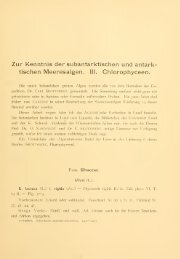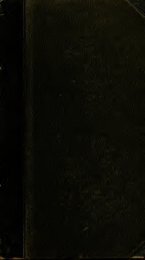Download PDF
Download PDF
Download PDF
You also want an ePaper? Increase the reach of your titles
YUMPU automatically turns print PDFs into web optimized ePapers that Google loves.
198<br />
ZYGNEMATACEAE<br />
in which the tubes are similarly formed by the male cell, but the segregation<br />
ot reproductive and vegetative cells is not so evident.<br />
181. Spirogyra prescottii (Prescott) Transeau 1944. Ohio Jour.<br />
Set. 44, p. 243. Amer. Midland Naturalist. 27, p. 673,<br />
PI. 4, Figs. 15-17. 1942 (as S. collinsii var. minor).<br />
Vegetative cells 13-14/i. x 1 15-140 /i, with plane end walls; i chromatophore,<br />
loosely spiraled; conjugation scalariform; tubes formed by<br />
the male gametangia; fertile cells inflated to ^7^ix\ zygospores ovoid to<br />
ellipsoid, 29 /^ x 39-40 /a; median spore wall coarsely punctate, yellow.<br />
United States: Massachusetts, Falmouth, July, 1933.<br />
The dimensions are so much smaller than those of S. collinsii that it<br />
seems better to separate it as a distinct species, although it is certainly very<br />
similar in other respects. Named for G. W. Prescott, State College, Mich-<br />
igan, author of many publications on fresh-water algae including Algae of<br />
Iowa.<br />
182. Spircx5yra chenii Jao 1935. Sinensia. 6, p. 587, PI. 4, Fig. 52.<br />
Vegetative cells 19-22 jia x 38-11 ju,, with plane end walls; i chromatophore,<br />
making i to 5 turns in the cell; conjugation lateral and<br />
scalariform; conjugating tubes formed by the male gametangia; fertile<br />
cells inflated up to ju, 42 usually separated by i or more sterile cells;<br />
zygospores ellipsoid, /u. 25-32 x 45-61 yu,; median spore wall smooth, yellow<br />
at maturity. (Pi. XXXIII, Fig. 14.)<br />
China, Szechwan.<br />
183. Spirogyra collinsii (Lewis) Printz 1927. Engler and Prantl.<br />
Pflazenfamilien. Second edition, 3, p. 371. Amer. Jour.<br />
Bot. 12, p. 351, 1925 (as Temnogyra eoUinsii).<br />
Vegetative cells 18-22/^ x 100-200/^, with plane end walls; i chro-<br />
matophore, rarely 2 in some cells, making from 3 to 9 turns in the cell;<br />
conjugation usually lateral, sometimes scalariform; tubes formed mostly<br />
by the male gametangia; fertile cells inflated, 25-39 ;u x 45-110 jli; zygospores<br />
ellipsoid, or sometimes ovoid, 26-37^ x 52-62 (-1 )u,; 10) median<br />
spore wall coarsely punctate, yellow. (PI. XXXIII, Figs. 12-13.)<br />
United States: Massachusetts, Woods Hole, July, 1922; Mississippi,<br />
Biloxi, February 14, 1934 (Hicks Coll.); Florida, Daytona, March 12, 1931<br />
(Tiffany Coll.), and Tarpon Springs, August 7, 1945 (R. K. Salisbury<br />
Coll.).<br />
This species is one of the most specialized of the "punctata group" in<br />
that the gametangia are much smaller than the vegetative cells, and most of<br />
the chromatophore passes into the gametangial end during cell division,<br />
leaving only a small portion in the sterile cell. This remnant is often flat<br />
and straight, or only slightly curved, as in Mougtotia. When I first saw<br />
the species in the Biloxi collections 1 took it to be a Temnogametum until I




